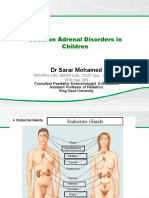Aquifer Case - Summary - FamilyMedicine12 - 16-Y
Aquifer Case - Summary - FamilyMedicine12 - 16-Y
Uploaded by
Hyunsoo EllisCopyright:
Available Formats
Aquifer Case - Summary - FamilyMedicine12 - 16-Y
Aquifer Case - Summary - FamilyMedicine12 - 16-Y
Uploaded by
Hyunsoo EllisOriginal Title
Copyright
Available Formats
Share this document
Did you find this document useful?
Is this content inappropriate?
Copyright:
Available Formats
Aquifer Case - Summary - FamilyMedicine12 - 16-Y
Aquifer Case - Summary - FamilyMedicine12 - 16-Y
Uploaded by
Hyunsoo EllisCopyright:
Available Formats
Family Medicine 12: 16-year-old female with vaginal
bleeding and UCG
User: hyunsoo Ellis
Email: helli6925@ung.edu
Date: November 28, 2020 3:37AM
Learning Objectives
The student should be able to:
Describe the essential features of a preconception consultation, including how to incorporate this content into any visit.
Discuss chlamydia screening.
Demonstrate the use of the HEEADSS adolescent-interviewing technique.
Recognize pregnancy: intrauterine, ectopic, and miscarriage.
Discuss options during an unplanned pregnancy.
Select initial prenatal labs.
Counsel a pregnant patient for healthy behavior, folic acid supplementation, and immunizations.
Outline normal progression of symptoms and physical exam findings during pregnancy.
Demonstrate the management of a miscarriage, including the medical and social follow-up.
Knowledge
Chlamydia: Epidemiology, Course of Disease, and Screening Recommendations
Epidemiology
Chlamydial infection is the most common sexually transmitted bacterial infection in the United States. In 2007, more than 1.1
million chlamydia cases were reported to the CDC. It is thought that another million cases of chlamydia remain unreported.
Course of disease
Chlamydia is often insidious and asymptomatic. In women, genital chlamydial infection may result in urethritis, cervicitis, pelvic
inflammatory disease (PID), infertility, ectopic pregnancy, and chronic pelvic pain. Chlamydial infection during pregnancy is related
to adverse pregnancy outcomes, including miscarriage, premature rupture of membranes, preterm labor, low birth weight, and
infant mortality.
Screening recommendations
The USPSTF found fair evidence that nucleic acid amplification tests (NAATs) can identify chlamydial infection in asymptomatic
men and women, including asymptomatic pregnant women, with high test specificity. In low prevalence populations, however, a
positive test is more likely to be a false positive than a true positive, even with the most accurate tests available.
Qualities of a Good Screening Test
1. The condition should be an important health problem and the condition screened for must have a high prevalence in the
population.
2. There should be a latent stage of the disease.
3. There should also be effective treatment for the condition being screened.
4. Facilities for diagnosis and treatment should be available.
5. There should be a test or examination for the condition.
6. The test should be acceptable to the population and the total cost of finding a case should be economically balanced in
relation to medical expenditure as a whole. The potential benefits of early detection and treatment of a condition need to be
weighed against many factors, including adverse side effects of the screening test, time and effort required (of both the
patient and the health care system) to take the test, financial cost of the test, potential psychological and physical harm of
false positive results (such as labeling and overtreatment), and adverse effects of the treatment.
7. The natural history of the disease should be adequately understood.
8. There should be an agreed policy on whom to treat.
9. Case-finding should be a continuous process, not just a "once and for all" project.
10. An effective screening test should have very good sensitivity (identify most or all potential cases) and specificity (label
incorrectly as few as possible as potential cases). Even a test with a sensitivity of 95% will lead to many false positives when
the prevalence of the condition is very low.
United States Preventive Services Task Force Recommendations for Chlamydia Screening
The USPSTF
© 2020 Aquifer 1/9
recommends screening Grade Rationale:
for chlamydia infection Recommendation
in the following:
All sexually active
women age 24 and
younger There is direct evidence that screening reduces complications of chlamydial
Grade B infection in women who are at increased risk, with a moderate magnitude of
Sexually active recommendation benefit. Such complications include pelvic inflammatory disease, infertility, and
women age 25 and premature delivery (among pregnant women).
older who are at
increased risk
The USPSTF advises against screening women age 25 and older if not at increased risk, regardless of pregnancy status.
Only the above categories are found to have a high enough pretest probability to recommend screening. Women (pregnant
or non-pregnant) in general are not recommended for chlamydial screening as the overall benefit of screening would be
small, given the low prevalence of infection among women not at increased risk.
Risk factors for chlamydial infection include a history of chlamydial or other sexually transmitted infection, new or multiple
sexual partners, inconsistent condom use, and exchanging sex for money or drugs. Risk factors for pregnant women are the
same as for nonpregnant women.
The USPSTF states that there is "Insufficient" evidence for or against screening men.
The CDC recommends consideration of screening for chlamydia in sexually active young men in settings with high
prevalence or in men with high risk behaviors overall.
1. The CDC recommends consideration of screening for chlamydia in sexually active young men in settings with high
prevalence or in men with high-risk behaviors overall.
2. The AAP recommends considering annual screening for chlamydia in sexually active males in settings with high prevalence
rates, such as jail or juvenile correction facilities, national job training programs, STD clinics, high school clinics, and
adolescent clinics (for patients who have a history of multiple partners), as well as routine annual screening for men who
have sex with men.
There are several good sources for preventive screening recommendations. The Guidelines for Adolescent Preventive Services
(GAPS) was developed by the AMA in 1993. Other recommendations include those from the American Academy of Pediatrics'
Bright Futures and the U.S. Preventive Services Task Force.
Adolescent Health Counseling and Screening: Preventing Sexually Transmitted Infection and
Unintended Pregnancy
Counsel all sexually active adolescents regarding contraception.
Options include: oral contraceptives, medroxyprogesterone (Depo-Provera) injections, long-acting reversible contraceptives
such as implantable options and IUDs, as well as the vaginal ring (NuvaRing)
Remind patients these options do not protect against sexually transmitted infections
Discuss condoms and abstinence
Discuss emergency contraception
Recommend folic acid supplementation to prevent neural tube defects in the event of pregnancy
Preconception Counseling
It can be challenging to find the opportunity to discuss reproductive life planning. Whether it is walk-in / urgent care visits, sports
pre-participation examinations, or adolescent well-child exams, it can be helpful to bring this topic up to allow for adequate
counseling around pregnancy prevention or preconception planning, as appropriate.
Preconception Health Care Checklist:
Genetic
Folic acid supplement (400 mcg routine):
The USPSTF recommends that all women "planning or capable of pregnancy" take a daily supplement containing 400 to 800
mcg of folic acid.
The dose is increased for the following high-risk scenarios:
A. 1 mg in patients with diabetes or epilepsy
B. 4 mg in patients who bore a child with a previous neural tube defect
Carrier screening (ethnic background):
Sickle cell anemia
Thalassemia
Tay-Sachs disease
Carrier screening (family history):
Cystic fibrosis
Nonsyndromic hearing loss (connexin-26)
Screen for infectious diseases, treat, immunize, counsel
© 2020 Aquifer 2/9
HIV
Syphilis
Hepatitis B immunization
Preconception immunizations (rubella, varicella)
Toxoplasmosis—avoid cat litter, garden soil, raw meat
Cytomegalovirus, parvovirus B19 (fifth disease)—frequent hand washing, universal precautions for child care and health
care
Environmental toxins
Occupational exposures: material safety data sheets from employer
Household chemicals: avoid paint thinners and strippers, other solvents, pesticides
Smoking cessation: bupropion (Zyban), nicotine patches (Nicoderm)
Screen for alcoholism and use of illegal drugs
Medical assessment
Diabetes: optimize control, folic acid, 1 mg per day, off ACE-inhibitors
Hypertension: avoid ACE inhibitors, angiotensin II receptor antagonists, thiazide diuretics
Epilepsy: optimize control; folic acid, 1 mg per day
DVT: switch from warfarin (Coumadin) to heparin
Depression/anxiety: avoid benzodiazepines
Lifestyle
Recommend regular moderate exercise
Avoid hyperthermia (hot tubs, overheating)
Caution against obesity and being underweight
Screen for domestic violence
Assess risk of nutritional deficiencies (vegan, pica, milk intolerance, calcium or iron deficiency)
Avoid overuse of Vitamin A (recommendations are to 750 mcg (2500 IU per day) with daily upper intake limit of 3,000 mcg
(10,000 IU))
Avoid overuse of Vitamin D (recommendations are 600 IU per day, tolerable upper intake is 4000 IU)
Caffeine (limit to the equivalent of two cups of coffee or six glasses of soda per day)
Note: The sugar intake in six glasses of soda is not recommended.
Signs and Symptoms of Pregnancy
Amenorrhea with fatigue, nausea, and/or vomiting as well as breast changes, including tenderness, are the classic
presentations of pregnancy.
Urinary frequency can also occur. Although urinary frequency can be a normal symptom of pregnancy, the possibility of a UTI in
a pregnant woman should also be considered.
Softening of the cervix is known as Goodell's sign, while softening of the uterus is known as Hegar's sign.
The bluish-purple hue in the cervix and vaginal walls is known as Chadwick's sign and is caused by hyperemia.
Enlargement of the uterus can be detected by an experienced examiner as early as 8 weeks on bimanual exam. Around 12
weeks, the uterine fundus can be palpated above the symphysis pubis. Between 20 to 36 weeks of gestation, the uterine
enlargement, measured in centimeters, approximates gestational age and will become a routinely elicited physical exam finding.
Fetal heart tones are typically elicited by hand-held Doppler between 10-12 weeks gestation.
Fetal movement or "quickening" is detected by the mother around 18-20 weeks of gestation.
Unfortunately, the menstrual history is not an entirely reliable indicator of pregnancy. Only 68% of pregnant adolescents report
having missed a menses. Conversely, not every adolescent who misses a menses is pregnant because anovulatory cycles are
normal in the early postmenarcheal years. Bleeding can occur in early pregnancy around the time of the missed menses as a
result of an invasion of the trophoblast into the decidua (implantation bleed). Some adolescents mistake this bleeding for a
menses, leading to a delay in diagnosis of pregnancy and potential misdating of the pregnancy. We should also remember that
young women who have not yet menstruated, but are sexually active, may be at risk for pregnancy because ovulation can
occasionally occur before the first menstrual period.
Reproductive Choice Counseling
Continue the pregnancy...
...and raise the child.
...and create an adoption plan.
Terminate the pregnancy...
...medically
...surgically
Abortion restrictions in the U.S. vary state to state, as shown here:
https://www.guttmacher.org/state-policy/explore/overview-abortion-laws
© 2020 Aquifer 3/9
Calculating Estimated Gestational Age
Calculating the estimated gestational age (EGA) based on the last normal menstrual period (LNMP). Calculating the EGA in this
manner is not only convenient but ubiquitous in clinical practice. Keep in mind, however, that the actual embryonic age (e.g., the
age of the fetus since the date of conception) will typically be approximately two weeks less than the clinically calculated EGA
based upon the LNMP.
The other calculation used in clinical practice—which patients care a great deal about—is the estimated due date.
Calculating the estimated due date (EDD—sometimes referred to as the estimated date of confinement or EDC) from the last
menstrual period is a relatively simple process that can be done with an obstetric "wheel", with an electronic calculator (e.g.,
http://www.mdcalc.com/pregnancy-due-dates-calculator ) or using Naegele's Rule.
Naegele's Rule is commonly described as starting with the first day of the last normal menstrual period, then:
add 1 year
subtract 3 months
add 1 week
For example, if a patient's LNMP was 7/10/2009, then:
7/10/2010 (+1 yr)
4/10/2010 (-3 mo)
4/17/2010 (+1 wk)
Thus, the EDD is 4/17/2010.
There are a variety of error corrections to Naegele's Rule and other ways to calculate the EDD in the first trimester that will be
discussed later.
Hemodynamic Instability
Typically, a significant bleed will first cause the pulse to rise and then the blood pressure to drop. Despite the fact that blood
pressure is normal, bleeding can continue for a while before the blood pressure reflects this. This finding really changes how
urgently you need to begin to make your assessment and, in some cases, intervene.
Rhesus immune globulin (RhoGam)
Rho(D) Immune Globulin is a critical part of modern obstetrics. Prior to the clinical use of this medication, Rh-negative mothers
with Rh-positive first gestations were at high risk of having subsequent gestations and developing hemolytic anemia, hydrops,
and/or fetal death. With every pregnancy, there is some passage of fetal red blood cells into the maternal circulation. This occurs
at either miscarriage or delivery and can even occur in small but significant quantities across the otherwise placental barrier.
When a mother with an intact immune system detects enough of the fetal Rho-D antigen, she forms antibodies to this antigen.
This immune response is usually not robust enough to impact the first gestation, but subsequent gestations are at significant risk
of an immune response. When this occurs, the maternal antibodies attack the fetus' red blood cells, causing hemolytic anemia,
which can lead to fetal hydrops and even fetal death.
Rho(D) Immune Globulin administered at appropriate times interrupts the maternal immunologic process. You can visualize this
process by imagining the RhoGAM attaching to all of the fetal Rho-D antigenic load, making it immunologically "invisible" to the
maternal immune system.
First Trimester Vaginal Bleeding
One in four pregnant patients experience vaginal bleeding during the first trimester.
When women have significant bleeding in the first trimester, there is a 25%-50% chance of miscarriage.
Ectropion
Ectropion: When the central part of the cervix appears red from the mucous-producing endocervical epithelium protruding
through the cervical os, onto the face of the cervix. It has no clinical significance and is common in women who are taking oral
contraceptive pills.
Estimating Gestational Age Based on Last Known Menstrual Period and Ultrasound
Recall that Naegele's rule for estimating date of delivery (EDD) is to subtract three months and add seven days to the first day of
the last menstrual period. Calculating today's estimated gestational age is typically done with an obstetrical "wheel" or a
handheld computer, but can be counted from the EDD on any calendar.
Ultrasounds have their own extensive nomograms that estimate gestational age from measured fetal size.
Accuracy
and
Trimester Measure Interpretation
© 2020 Aquifer 4/9
precision
If the EGA & EDD from the ultrasound measurements are within one week of the EGA /
EDD estimated from the LNMP, today's gestational age and the due date (EGA & EDD)
should not change to reflect the ultrasound calculations, as in this case.
First +/- 1 If, however, the ultrasound measurements suggest an EGA & EDD that is greater than
crown-rump length
trimester week seven days from the EGA & EDD calculated from the LNMP (or, in some cases, if the
LNMP is historically inaccurate), then the estimated gestational age today, as well as
the estimated due date, should be changed to reflect the ultrasound measurements
and estimates.
1. biparietal
diameter
2. head
Second circumference +/- 2 Same.
trimester weeks
3. abdominal
circumference
4. femur length
Fetal size cannot be used accurately to assess EGA or EDD and should not change a
due date.
This is because of the response of the fetus to internal and external insults. During the
1st and 2nd trimesters, many problems that develop result in pregnancy loss and/or
teratogenesis. However, during the third trimester, many fetal and maternal
Third +/- 3 challenges manifest themselves in fetal growth. Two examples would be macrosomia
trimester weeks due to gestational diabetes or intrauterine growth restriction as a part of the pre-
eclampsia syndrome. Additionally, fetal size discrepancies can be either familial or
idiopathic.
Since the ultrasound estimate of gestational age and due date is based on
measurements of fetal size compared to a computerized nomogram, these third-
trimester measurements should not be used for dating the EGA or EDD.
Spontaneous Abortion: Incidence, Causes, and Recurrence
Incidence
Miscarriages are very common: about one-third of all pregnancies end in miscarriage.
Causes
Women who have a spontaneous abortion and their partners frequently struggle with guilt about their role in the loss. Physicians
should address the issue of guilt with their patients and allay any concerns that they may have "caused" the spontaneous
abortion. There is no proof that stress or physical / sexual activity causes miscarriage. About half of all miscarriages that occur in
the first trimester are caused by chromosomal abnormalities.
Recurrence
Most women (87 percent) who have miscarriages have subsequent normal pregnancies and births.
Clinical Skills
HEEADSSS Adolescent Interview
Pre-participation exams are a great opportunity for prevention and counseling, as otherwise healthy adolescents may not come in
for this routinely.
HEEADSSS covers the following issues:
Home
Education / Employment
Eating
Activities
Drugs
Sexuality
Suicide / Depression
Safety / Violence
Remember that in caring for adolescents, every effort should be made to encourage the patient to involve parents in their health
care decisions. Nevertheless, teens have a right to be interviewed and examined without a parent or guardian in the room.
© 2020 Aquifer 5/9
Management
Management of Inevitable Abortion
In the setting of an inevitable (or similarly, an incomplete) spontaneous abortion, the traditional choices for management are
expectant management or surgical management.
Expectant management means watchful waiting with precautions regarding unusual amounts of bleeding or pain, or fever, and
is effective in over 75% of cases in this setting. The disadvantage with this course of action is that it can take up to a month for
the products of conception to be completely expelled. This timeframe might not normally be a problem, but a spontaneous
abortion is usually complicated by sadness, grief, and even guilt. Expectant management can delay emotional closure.
Nevertheless, this is a viable course of action.
Surgical options include dilation and curettage (D&C), with or without vacuum aspiration, or manual or electric vacuum
aspiration. These choices depend on a variety of factors, including primarily local resources and the surgeon's preference and
experience. The main indication for suction D&C is unusually heavy bleeding and patient preference. The main contraindication is
active pelvic infection and patient refusal.
Medical management, despite being off-label, is a useful third option that is becoming more common. The most common
protocol involves the vaginal administration of 800 mcg of misoprostol (Cytotec), possibly repeated on day three. Success with this
method is generally around 95%, and the time to completion is generally three to four days (but may take up to two weeks), as
opposed to two to six weeks with expectant management.
Finally, confirming the receipt of rhesus immune globulin (RhoGam) in the Rhesus negative patient is advisable. If it was not given
previously, it should now be administered.
Studies
Initial Pregnancy Laboratory Studies
CBC is important to detect various nutritional and congenital anemias, and to detect platelet disorders.
Hepatitis B surface antigen tests for hepatitis B, which is a major risk to the newborn. (Note: This is part of the initial
prenatal laboratory workup, despite the childhood immunization history.)
HIV status should be checked as the risk of perinatal transmission can be reduced from 15%-40% without treatment to less
than 2% with antiretroviral therapy and avoidance of breastfeeding and labor.
RPR tests for syphilis , which is of particular concern during pregnancy because of the risk of transplacental infection of
the fetus. Congenital infection is associated with several adverse outcomes, including:perinatal death, premature delivery,
low birth weight, congenital anomalies, and active congenital syphilis in the neonate.
Rubella immunity should be tested by assessing the presence of IgG antibodies. If the patient isn't immune, they should
receive a postpartum immunization. The Rubella and the MMR vaccine is a live-virus vaccine and should not be used during
pregnancy. (Note: This is part of the initial prenatal laboratory workup, despite the childhood immunization history.)
Blood type to detect rhesus antibody presence. RH(D)-negative women should receive anti (D)-immune globulin to prevent
hemolytic disease of the newborn.
It is probably not necessary to test serum hCG as well as urine hCG to confirm pregnancy, in the setting of a positive urine
hCG.
However, as early pregnancy urine hCG concentrations are lower than serum hCG concentrations, it is possible to have a positive
serum hCG result, even with a negative urine hCG result.
Additionally, one must specify a qualitative (positive vs. negative) vs. a quantitative serum hCG. Quantitative serum hCG levels
rise at a predictable rate, so serial testing of serum hCG levels can be useful to determine viability or to diagnose an ectopic
pregnancy, although one measurement alone is not sufficient to accurately estimate gestational age.
An ultrasound would not be the best test to order at an early stage of pregnancy. For example, at five weeks estimated
gestation, an embryo would typically not be seen. Furthermore, the results would be difficult to interpret without a serum
quantitative beta human chorionic gonadotropin test (quantitative pregnancy test).
Recommended Laboratory Studies to Investigate First Trimester Vaginal Bleeding
CBC: The main utility of the CBC is for the hemoglobin / hematocrit. The white blood cell (WBC) count is limited in its
usefulness to detect infection (and thus a septic abortion) during pregnancy because most pregnant patients have a mild
leukocytosis. Nevertheless, if significantly elevated, or associated with a bandemia, this test would need to be factored into
the consideration of a septic abortion.
Wet mount preparation for trichomonas, as well as PCR testing for gonorrhea and chlamydia: All sexually
transmitted infections can cause vaginal bleeding. These tests should be obtained in this clinical context, despite a
previously normal recent result.
Progesterone: Laboratory testing for progesterone is most useful in extreme situations. If the result is >25, it is highly
associated with a sustainable intrauterine pregnancy. If the result is <5, it is highly associated with an evolving miscarriage
or ectopic pregnancy. Levels between 5 and 25 have minimal diagnostic value in distinguishing intrauterine from ectopic
pregnancy. Algorithms for the diagnosis of ectopic pregnancy emphasizing progesterone measurements have been
associated with a higher use of surgical management and often miss ectopic pregnancy since 85% of ectopic pregnancies
© 2020 Aquifer 6/9
will have a normal progesterone level. Nevertheless, the test remains valuable because of its positive and negative
predictive value at the extremes of the reference range. In many labs, it is a common and quick test, which makes it
frequently ordered.
Quantitative beta-human chorionic gonadotropin (quant. beta-hCG): This test has enormous significance, and when
combined with the pelvic ultrasound, they are the definitive diagnostic modalities. However, in isolation, one beta-hCG can
be challenging to interpret, especially without the ultrasound results. Human chorionic gonadotropin is secreted by the
trophoblastic cells very early in embryonic life (day 7, post-ovulation). Additionally, testing for the beta-subunit is exquisitely
sensitive (down to 5 mIU/mL) and specific (the placenta is the only normal tissue that excretes beta-hCG). By the expected
date of menses, the beta-hCG is usually > or = 100 mIU/mL.
Furthermore, in a normal pregnancy, the beta-hCG approximately doubles every 48 hours for the first six to seven weeks of
gestation. However, an intrauterine pregnancy may not be conclusively detected until the quantitative beta-hCG reaches 1500-
1800. To detect an intrauterine pregnancy by transabdominal ultrasound, the beta-hCG will typically be >5000 mIU/mL. In both
ectopic gestations and spontaneous abortions, hCG levels are usually lower than normal and increase at less-than-normal rates
during early gestation. Molar pregnancy and multiple gestations are both associated with higher-than-normal hCG levels.
Not recommended:
Type and screen: Knowing the Rhesus status is critical, as all Rh negative women who are pregnant need to be given RhoGam
during any episode of bleeding. However, this does not need to be repeated after initial type and screen, especially in a setting
that does not appear that this is a major bleed. If the bleeding is of great volume, a type and screen would be warranted both for
potential transfusion and for Kleihauer-Betke testing, which helps to estimate the quantitative amount of fetal hemoglobin in the
maternal circulation and with dosing RhoGam.
Spontaneous Abortion
Spontaneous abortion is the loss of a pregnancy without outside intervention before 20 weeks' gestation. Spontaneous abortions
can be subdivided into:
Threatened abortion: bleeding before 20 weeks gestation.
Threatened abortion is simply a pregnancy complicated by bleeding before 20 weeks gestation, and is, in some ways, a "catch-all"
descriptive diagnosis.
Inevitable abortion: dilated cervical os.
Incomplete abortion: some but not all of the intrauterine contents (or products of conception) have been expelled.
Missed abortion: fetal demise without cervical dilitation and/or uterine activity (often found incidentally on ultrasound
without a presentation of bleeding).
Septic abortion: with intrauterine infection (abdominal tenderness and fever usually present).
Complete abortion: the products of conception have been completely expelled from the uterus.
Clinical Reasoning
Differential of First Trimester Vaginal Bleeding
Most Likely Diagnoses
There are many important causes of bleeding in early pregnancy, but the three most common are spontaneous abortion,
ectopic pregnancy, and idiopathic bleeding in a viable pregnancy.
Finding Significance
A cervical os dilated with obvious bleeding lends support to the diagnosis of a spontaneous abortion.
Physical A distended, acute abdomen may turn one's attention to the immediate possibility of a ruptured ectopic
Exam pregnancy.
Findings
However, an unremarkable pelvic exam does not rule out either a spontaneous abortion, ectopic pregnancy,
or a normal pregnancy.
Neither transabdominal nor transvaginal ultrasound can reliably detect an intrauterine pregnancy at a beta-
hCG level less than 1500 mIU/mL. A quantitative beta-hCG slightly less than 1500 mIU/ml does not argue for
or against a spontaneous abortion, an ectopic pregnancy, or a normal pregnancy.
Quantitative
beta-hCG However, the quantitative beta-hCG should approximately double every 48 hours in a normal pregnancy, so
the velocity of the increase or decrease is a more useful diagnostic modality than the point value in a stable
patient. If the patient is stable, 1-2 serial hCG measurement(s) can prove diagnostically useful and often
conclusive when combined with a repeat ultrasound.
An ovarian cyst is not necessarily abnormal, and a report stating "cannot rule out ectopic pregnancy" is a
classic reminder by the radiologist that they simply cannot rule out ectopic pregnancy.
One should be neither cavalier that such an ultrasound finding is a benign finding nor overly aggressive in
"treating" for a suspected ectopic pregnancy in a stable patient. Better to make the diagnosis more certain. It
© 2020 Aquifer 7/9
Ultrasound would be a mistake to assume a confirmed ectopic pregnancy and to begin either medical or surgical
treatment for ectopic pregnancy. This may, after all, prove in 48 hours to be the corpus luteum cyst
supporting a normal intrauterine pregnancy.
Intrauterine contents (e.g., gestational sac, fetal pole, etc.) are not expected to be seen until the quantitative
beta-hCG reaches > 1500 IU/L, so a serial reading (in the stable patient) is needed. In a stable patient
without active bleeding, serial readings every 48-72 hours would be appropriate.
At each lab reassessment, a clinical assessment should be done as well. At any time, a spontaneous abortion can cause
hemodynamic instability or a ruptured ectopic can prove life threatening.
If the patient was or has become unstable, a dilation and curettage (for an unstable spontaneous abortion) or a diagnostic
laparoscopy or laparotomy (for a suspected ruptured ectopic) would be the most appropriate course of action.
Less Likely Diagnoses
Gestational trophoblastic disease (GTD), or molar pregnancy, is a heterogeneous constellation of conditions whereby the placenta
acts like a tumor. GTDs are usually benign, but can sometimes be malignant. Typically, they have a characteristic appearance on
ultrasound and are associated with markedly increased (>100,000 mIU/mL) quantitative hCG levels.
Vaginal trauma and cervical pathology are unlikely if nothing abnormal is seen on physical exam. However, these can't be ruled
out conclusively until gonorrhea and chlamydia results are obtained.
References
Abortion rules by state.
Fact Sheet on Vitamin A
Fact Sheet on Vitamin D
American Academy of Family Physicians. AAFP Policy on Reproductive Decisions: 1989-2006. Accessed April 28, 2017.
Brudage SC. Preconception Health Care. Am Fam Physician. 2002 Jun 15;65(12):2507-2515. Dec. 6, 2019.
Centers for Disease Control and Prevention. 2015 Sexually Transmitted Disease Treatment Guidelines: Screening Recommendations
and Considerations Referenced in Treatment Guidelines and Original Sources. Accessed June 16, 2020.
Centers for Disease Control and Prevention. Chickenpox Vaccination: What Everyone Should Know. Accessed April 17, 2017.
Centers for Disease Control and Prevention. Sexually transmitted diseases treatment guidelines 2006. MMWR Recomm Tep.
2006;55(RR-11):7.
Cleveland Clinic. Miscarriage. http://my.clevelandclinic.org/disorders/Miscarriage/hic_Miscarriage.aspx. Accessed April 28, 2017.
Committee on Adolescence and Society for Adolescent Health and Medicine. Screening for Nonviral Sexually Transmitted Infections in
Adolescents and Young Adults. Pediatrics. July 2014, 134 (1) e302-e311.
Edelman A, Anderson J, Lai S, Braner DAV, Tegtmeyer K. Pelvic examination, N Engl J Med. 2007; 356(26):e26. Accessed Dec. 6, 2019.
Edelman A, Anderson J, Lai S, Braner DAV, Tegtmeyer K. Pelvic examination. N Engl J Med. 2007;356(26):e26 (Web only). Accessed
Dec. 6, 2019.
Fossum GT, et al. Early detection of pregnancy with transvaginal ultrasound. Fertil Steril. 1998;49:788.
Gabbe S, Niebyl J, Simpson J. Red Cell Alloimmunization. In: Obstetrics: Normal and Problem Pregnancies. 5th ed. Philadelphia:
Churchill Livingstone Elsevier; 2007.
Griebel C, Halvorsen J, Golemon, T, Day A. Management of Spontaneous Abortion. Am Fam Physician. 2005 Oct 1;72(7):1243-50.
http://www.aafp.org/afp/2005/1001/p1243.html. Accessed April 28, 2017.
Griebel CP, Halvorsen J, Golemon TB, Day AA. Management of spontaneous abortion. Am Fam Physician. 2005;72:1243-50.
Griebel CP, Halvorsen J, Golemon TB, Day AA. Management of spontaneous abortion. Am Fam Physician. 2005;72:1243-50.
http://www.aafp.org/afp/2005/1001/p1243.html. Accessed April 28, 2017.
Institute of Medicine, Food and Nutrition Board. Dietary Reference Intakes for Calcium and Vitamin D. Washington, DC: National
Academy Press, 2010.
Lozeau AM, Potter B. Diagnosis and management of ectopic pregnancy. Am Fam Physician. 2005;72:1707-14.
http://www.aafp.org/afp/2005/1101/p1707.html. Accessed June 2, 2017.
Meyers, DS, Halvorson, H, Luckhaupt, S. Screening for chlamydial infection: an evidence update for the U.S. Preventive Services Task
Force. Ann Intern Med. 2007;147:135.
National Institute of Health Office of Dietary Supplements
New York Times. (Slideshow) Rh Incompatibility. NYTimes Health Section: http://ow.ly/JqnW. Accessed April 28, 2017.
Polaneczky M, O'Connor K. Pregnancy in the adolescent patient: Screening, diagnosis, and initial management. Pediatr Clin North Am.
August, 1999;46(4):649-70, x.PMID:10494250.
© 2020 Aquifer 8/9
Speroff L, et al. Ectopic Pregnancy. In Clinical Gynecologic Endocrinology and Infertility. Ed. 5. Baltimore, MD: Williams & Wilkins;
1994.
U.S. Preventive Services Task Force. Folic acid for the prevention of neural tube defects: U.S. Preventive Services Task Force
recommendation statement. Ann Intern Med 2009;150:626-31.
USPSTF. Folic Acid for the Prevention of Neural Tube Defects: U.S. Preventive Services Task Force Recommendation Statement. Ann
Int Med, 2009; 150:626-631. Accessed March 6, 2017.
USPSTF. Folic Acid to Prevent Neural Tube Defects.
Wilson JMG, Jungner G. (1968) Principles and practice of screening for disease (large pdf). WHO Chronicle Geneva: World Health
Organization. 22(11):473. Public Health Papers, #34. https://apps.who.int/iris/bitstream/handle/10665/37650/WHO_PHP_34.pdf?
sequence=17 Accessed June 16, 2020.
© 2020 Aquifer 9/9
You might also like
- The Subtle Art of Not Giving a F*ck: A Counterintuitive Approach to Living a Good LifeFrom EverandThe Subtle Art of Not Giving a F*ck: A Counterintuitive Approach to Living a Good LifeRating: 4 out of 5 stars4/5 (5982)
- The Gifts of Imperfection: Let Go of Who You Think You're Supposed to Be and Embrace Who You AreFrom EverandThe Gifts of Imperfection: Let Go of Who You Think You're Supposed to Be and Embrace Who You AreRating: 4 out of 5 stars4/5 (1112)
- Never Split the Difference: Negotiating As If Your Life Depended On ItFrom EverandNever Split the Difference: Negotiating As If Your Life Depended On ItRating: 4.5 out of 5 stars4.5/5 (898)
- Hidden Figures: The American Dream and the Untold Story of the Black Women Mathematicians Who Helped Win the Space RaceFrom EverandHidden Figures: The American Dream and the Untold Story of the Black Women Mathematicians Who Helped Win the Space RaceRating: 4 out of 5 stars4/5 (932)
- Grit: The Power of Passion and PerseveranceFrom EverandGrit: The Power of Passion and PerseveranceRating: 4 out of 5 stars4/5 (619)
- Shoe Dog: A Memoir by the Creator of NikeFrom EverandShoe Dog: A Memoir by the Creator of NikeRating: 4.5 out of 5 stars4.5/5 (546)
- The Hard Thing About Hard Things: Building a Business When There Are No Easy AnswersFrom EverandThe Hard Thing About Hard Things: Building a Business When There Are No Easy AnswersRating: 4.5 out of 5 stars4.5/5 (357)
- Her Body and Other Parties: StoriesFrom EverandHer Body and Other Parties: StoriesRating: 4 out of 5 stars4/5 (831)
- Elon Musk: Tesla, SpaceX, and the Quest for a Fantastic FutureFrom EverandElon Musk: Tesla, SpaceX, and the Quest for a Fantastic FutureRating: 4.5 out of 5 stars4.5/5 (476)
- The Emperor of All Maladies: A Biography of CancerFrom EverandThe Emperor of All Maladies: A Biography of CancerRating: 4.5 out of 5 stars4.5/5 (275)
- The Little Book of Hygge: Danish Secrets to Happy LivingFrom EverandThe Little Book of Hygge: Danish Secrets to Happy LivingRating: 3.5 out of 5 stars3.5/5 (425)
- The World Is Flat 3.0: A Brief History of the Twenty-first CenturyFrom EverandThe World Is Flat 3.0: A Brief History of the Twenty-first CenturyRating: 3.5 out of 5 stars3.5/5 (2272)
- The Yellow House: A Memoir (2019 National Book Award Winner)From EverandThe Yellow House: A Memoir (2019 National Book Award Winner)Rating: 4 out of 5 stars4/5 (99)
- The Sympathizer: A Novel (Pulitzer Prize for Fiction)From EverandThe Sympathizer: A Novel (Pulitzer Prize for Fiction)Rating: 4.5 out of 5 stars4.5/5 (125)
- Devil in the Grove: Thurgood Marshall, the Groveland Boys, and the Dawn of a New AmericaFrom EverandDevil in the Grove: Thurgood Marshall, the Groveland Boys, and the Dawn of a New AmericaRating: 4.5 out of 5 stars4.5/5 (270)
- Team of Rivals: The Political Genius of Abraham LincolnFrom EverandTeam of Rivals: The Political Genius of Abraham LincolnRating: 4.5 out of 5 stars4.5/5 (235)
- Immunohematology MCQsDocument21 pagesImmunohematology MCQsMeerva El-zein88% (26)
- A Heartbreaking Work Of Staggering Genius: A Memoir Based on a True StoryFrom EverandA Heartbreaking Work Of Staggering Genius: A Memoir Based on a True StoryRating: 3.5 out of 5 stars3.5/5 (232)
- Chakras Caroline Myss PDFDocument7 pagesChakras Caroline Myss PDFnalarconpadialNo ratings yet
- On Fire: The (Burning) Case for a Green New DealFrom EverandOn Fire: The (Burning) Case for a Green New DealRating: 4 out of 5 stars4/5 (75)
- Algorithm-Acls Lvad 200808Document1 pageAlgorithm-Acls Lvad 200808Hyunsoo EllisNo ratings yet
- The Unwinding: An Inner History of the New AmericaFrom EverandThe Unwinding: An Inner History of the New AmericaRating: 4 out of 5 stars4/5 (45)
- Pharma CardsDocument5 pagesPharma CardsazancheNo ratings yet
- MeropenemDocument2 pagesMeropenemMaria Krishielle Fabian100% (1)
- Aquifer Case - Summary - FamilyMedicine23 - 5-YeDocument9 pagesAquifer Case - Summary - FamilyMedicine23 - 5-YeHyunsoo EllisNo ratings yet
- Aquifer Case - Summary - FamilyMedicine17 - 55-YDocument9 pagesAquifer Case - Summary - FamilyMedicine17 - 55-YHyunsoo EllisNo ratings yet
- Aquifer Case - Summary - FamilyMedicine32 - 33-YDocument9 pagesAquifer Case - Summary - FamilyMedicine32 - 33-YHyunsoo EllisNo ratings yet
- Aquifer Case - Summary - FamilyMedicine21 - 12-YDocument10 pagesAquifer Case - Summary - FamilyMedicine21 - 12-YHyunsoo EllisNo ratings yet
- Algorithm-ACLS CA in Pregnancy In-Hospital 200612Document1 pageAlgorithm-ACLS CA in Pregnancy In-Hospital 200612Hyunsoo EllisNo ratings yet
- Algorithm-ACLS CA 200731Document1 pageAlgorithm-ACLS CA 200731Hyunsoo EllisNo ratings yet
- Abg Analysis TransDocument3 pagesAbg Analysis TransJulia MundoNo ratings yet
- اسئله اطفال مدفقه 740804Document39 pagesاسئله اطفال مدفقه 740804Ashraf AlbhlaNo ratings yet
- Emergency Viva (Full)Document48 pagesEmergency Viva (Full)ashokarathnasingheNo ratings yet
- K P Differential Diagnosis Pyramid: OPMAPS: Sychiatry EvisionDocument36 pagesK P Differential Diagnosis Pyramid: OPMAPS: Sychiatry EvisionArama Cristi100% (2)
- Adrenal Disorders in ChildrenDocument50 pagesAdrenal Disorders in ChildrenadinayNo ratings yet
- BSUH Emergency Prompt Card Version 5.0Document95 pagesBSUH Emergency Prompt Card Version 5.0Chris Jardine LiNo ratings yet
- Juvenile Nasopharyngeal Angiofibroma: Ashish K.gupta SMS Medical College JaipurDocument67 pagesJuvenile Nasopharyngeal Angiofibroma: Ashish K.gupta SMS Medical College JaipuryasinoNo ratings yet
- Epicor Prevents and Reduces Inflammation in Two Separate Experimental Immune Animal ModelsDocument8 pagesEpicor Prevents and Reduces Inflammation in Two Separate Experimental Immune Animal ModelssteeljackNo ratings yet
- OB Patho Assessment Tool EditedDocument6 pagesOB Patho Assessment Tool EditedDarren RobertoNo ratings yet
- 10 1016@j Det 2018 05 008Document8 pages10 1016@j Det 2018 05 008Renata GoulartNo ratings yet
- Guia Manejo Osteoporosis 2019Document28 pagesGuia Manejo Osteoporosis 2019SMIBA MedicinaNo ratings yet
- Biochimica Et Biophysica Acta: Shankar J. Chinta, Julie K. AndersenDocument6 pagesBiochimica Et Biophysica Acta: Shankar J. Chinta, Julie K. Andersen20alvaroNo ratings yet
- Physio Uhs Solved Past Papers 2nd Year Mbbs WWW Edu Apnafort ComDocument130 pagesPhysio Uhs Solved Past Papers 2nd Year Mbbs WWW Edu Apnafort ComHamza AhmedNo ratings yet
- ENT Vertigo FINAL v0.41Document1 pageENT Vertigo FINAL v0.41Farmasi Bhamada100% (1)
- PlasentaDocument15 pagesPlasentaIpan MahendriyansaNo ratings yet
- Delirium and DementiaDocument12 pagesDelirium and DementiaardaineannramosNo ratings yet
- Complication of POPDocument23 pagesComplication of POPKasey Chase0% (1)
- Preparation Support Pack 180515Document69 pagesPreparation Support Pack 180515sinbad200No ratings yet
- SelulitisDocument37 pagesSelulitiswindhymonicaNo ratings yet
- HNBB & Febsan Drug StudyDocument4 pagesHNBB & Febsan Drug StudyKeziah PilotosNo ratings yet
- Drug Study...Document5 pagesDrug Study...Ezra Dizon ManzanoNo ratings yet
- Seizure Disorders and Management in Primary Health CareDocument83 pagesSeizure Disorders and Management in Primary Health CareChidi MbatuegwuNo ratings yet
- Spanish Medical GlossaryDocument129 pagesSpanish Medical GlossaryAlex ObandoNo ratings yet
- Diuretics in States of Volume Overload Core Curriculum 2022Document13 pagesDiuretics in States of Volume Overload Core Curriculum 2022Fercho MedNo ratings yet
- Endocrine PDFDocument5 pagesEndocrine PDFRegina SantosNo ratings yet
- Clinical Manifestations and Evaluation of Edema in AdultsDocument9 pagesClinical Manifestations and Evaluation of Edema in AdultsRafan AddisNo ratings yet













































































